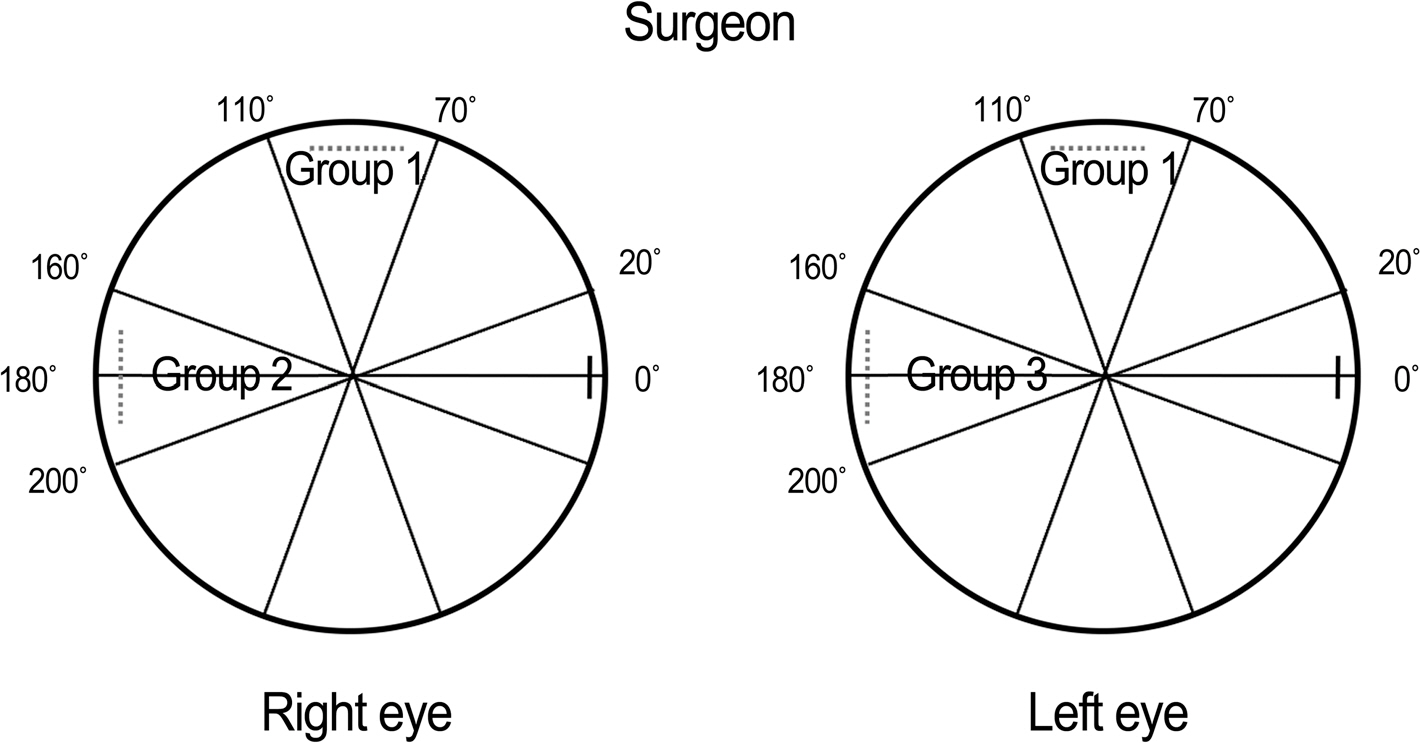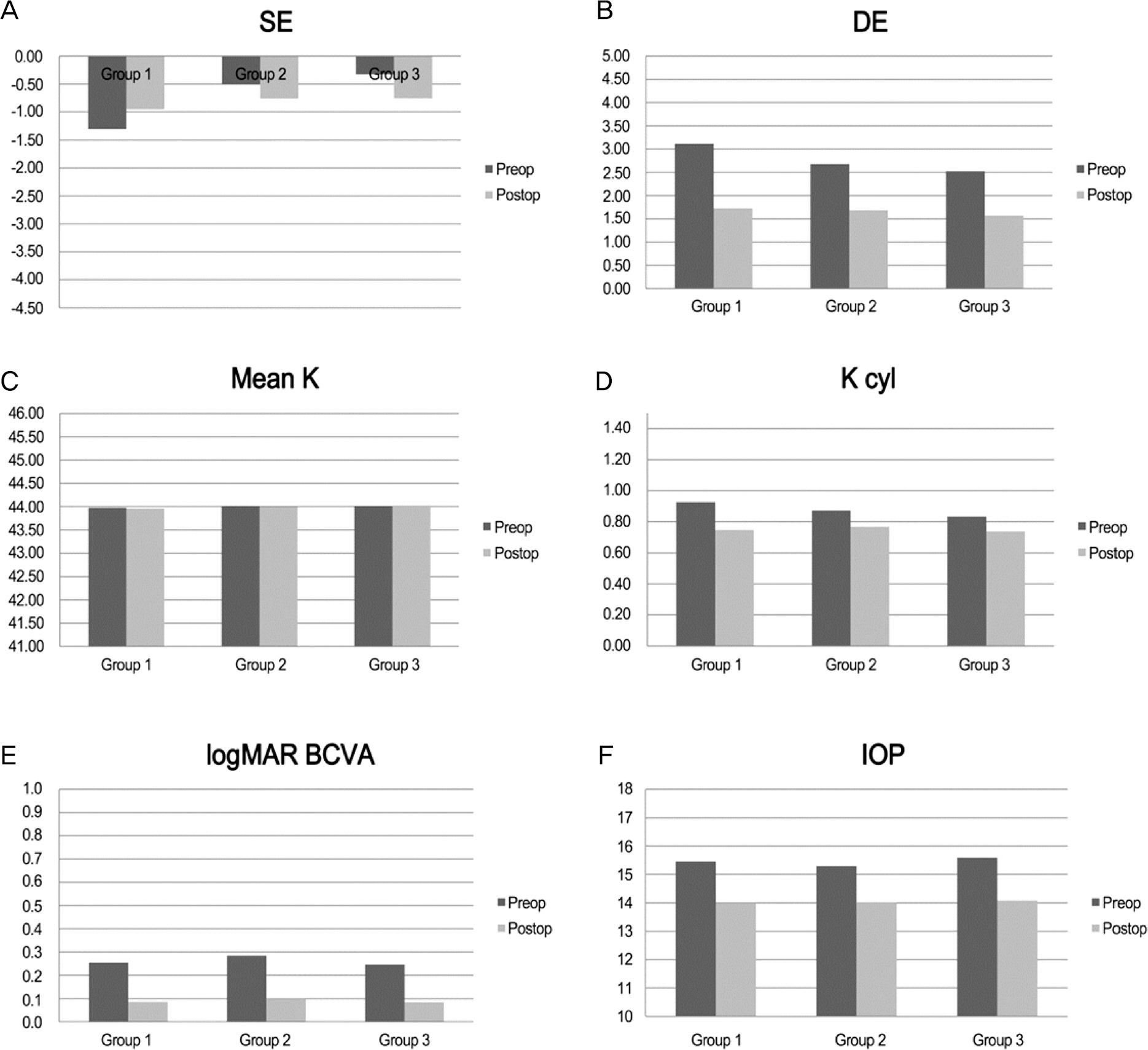J Korean Ophthalmol Soc.
2017 Feb;58(2):140-146. 10.3341/jkos.2017.58.2.140.
Clinical Outcomes of Cataract Surgery Using Nasal Clear Corneal Incision: Safety and Efficacy
- Affiliations
-
- 1Department of Ophthalmology, Asan Medical Center, University of Ulsan College of Medicine, Seoul, Korea. hwtchah@amc.seoul.kr
- 2Asan Institute for Life Science, Asan Medical Center, University of Ulsan College of Medicine, Seoul, Korea.
- KMID: 2369460
- DOI: http://doi.org/10.3341/jkos.2017.58.2.140
Abstract
- PURPOSE
To compare the safety and efficacy of cataract surgery using nasal clear corneal incision (CCI) versus superior or temporal CCIs in Korean patients.
METHODS
A retrospective comparative study was conducted. Patients underwent cataract surgery using CCI performed by 3 surgeons between January 2012 and December 2013.The patients were divided into the following 3 groups based on CCI direction: nasal CCIs (group I), superior CCIs (Group II), and temporal CCIs (Group III). To assess usability, surgically induced astigmatism (SIA), best-corrected visual acuity (BCVA), intraocular pressure (IOP), keratometry reading, and refractive errors at baseline and 1 month after surgery were compared. Operation times were compared between groups. To assess safety, intraoperative complications and wound stability were compared.
RESULTS
A total of 1,374 eyes (Group I, 283 eyes; Group II, 587 eyes; Group III, 504 eyes) were included in the present study. The SIA was not significantly different among the 3 groups. The postoperative mean BCVA, IOP, keratometry reading and spherical equivalent as well as the mean operation times were not significantly different between the 3 groups (14.04 ± 3.79 vs. 13.80 ± 3.27 vs. 13.80 ± 3.70; p = 0.473). The rate of intraocular complications and incidence of corneal wound suture were not significantly different between the 3 groups (1.7% vs. 3.2% vs. 2.3%; p = 0.378).
CONCLUSIONS
The safety and efficacy of cataract surgery using nasal CCI were not significantly different compared with the use of temporal or superior CCI. Our results showed that cataract surgery using nasal CCI can be performed safely and conveniently in Korean patients.
Keyword
MeSH Terms
Figure
Reference
-
References
1. Dewey S, Beiko G, Braga-Mele R. . Microincisions in cataract surgery. J Cataract Refract Surg. 2014; 40:1549–57.
Article2. Alió J, Rodríguez-Prats JL, Galal A, Ramzy M.Outcomes of mi-croincision cataract surgery versus coaxial phacoemulsification. Ophthalmology. 2005; 112:1997–2003.
Article3. Alió JL, Agdeppa MC, Rodríguez-Prats JL. . Factors influenc-ing corneal biomechanical changes after microincision cataract surgery and standard coaxial phacoemulsification. J Cataract Refract Surg. 2010; 36:890–7.
Article4. Barequet IS, Yu E, Vitale S. . Astigmatism outcomes of hori-zontal temporal versus nasal clear corneal incision cataract surgery. J Cataract Refract Surg. 2004; 30:418–23.
Article5. Leaming DV. Practice styles and preferences of ASCRS mem-bers--1997 survey. J Cataract Refract Surg. 1998; 24:552–61.
Article6. Amesbury EC, Miller KM. Correction of astigmatism at the time of cataract surgery. Curr Opin Ophthalmol. 2009; 20:19–24.
Article7. Jiang Y, Le Q, Yang J, Lu Y. Changes in corneal astigmatism and high order aberrations after clear corneal tunnel phacoemulsifica-tion guided by corneal topography. J Refract Surg. 2006; 22((9 Suppl)):S1083–8.
Article8. Gonçalves FP, Rodrigues AC.Phacoemulsification using clear cor-nea incision in steepest meridian. Arq Bras Oftalmol. 2007; 70:225–8.9. Altan-Yaycioglu R, Akova YA, Akca S. . Effect on astigma-tism of the location of clear corneal incision in phacoemulsifica-tion of cataract. J Refract Surg. 2007; 23:515–8.
Article10. Pakravan M, Nikkhah H, Yazdani S. . Astigmatic outcomes of temporal versus nasal clear corneal phacoemulsification. J Ophthalmic Vis Res. 2009; 4:79–83.11. Kohnen S, Neuber R, Kohnen T. Effect of temporal and nasal un-sutured limbal tunnel incisions on induced astigmatism after phacoemulsification. J Cataract Refract Surg. 2002; 28:821–5.
Article12. Yoon JH, Kim KH, Lee JY, Nam DH. Surgically induced astigma-tism after 3.0 mm temporal and nasal clear corneal incisions in bi-lateral cataract surgery. Indian J Ophthalmol. 2013; 61:645–8.
Article13. Holladay JT, Cravy TV, Koch DD. Calculating the surgically in-duced refractive change following ocular surgery. J Cataract Refract Surg. 1992; 18:429–43.
Article14. Tejedor J, Pérez-Rodríguez JA.Astigmatic change induced by 2.8-mm corneal incisions for cataract surgery. Invest Ophthalmol Vis Sci. 2009; 50:989–94.
Article15. Park CY, Chuck RS, Channa P. . The effect of corneal anterior surface eccentricity on astigmatism after cataract surgery. Ophthalmic Surg Lasers Imaging. 2011; 42:408–15.
Article16. Jang YJ, Alfanta EM. Rhinoplasty in the Asian nose. Facial Plast Surg Clin North Am. 2014; 22:357–77.
Article
- Full Text Links
- Actions
-
Cited
- CITED
-
- Close
- Share
- Similar articles
-
- Clinical Results According to Site of Clear Corneal Incision in Combined Vitrectomy and Cataract Surgery
- The Corneal Topographic Changes in Sutureless Cataract Surgery
- Mid Limbal Incision vs Scleral Pocket Incision in Cataract Surgery
- The Comparison of Corneal Sensitivity after Temporal and Superior Clear Corneal Incisions in Cataract Surgery
- Correction of with-the-rule Astigmatism by Superior Clear Corneal Incision and Transverse Keratotomy in Cataract Surgery



